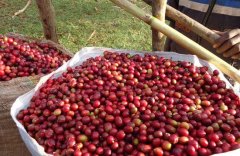What is the treatment of red wine? What are the advantages of coffee and red wine treatment? The steps of red wine treatment.

Professional coffee knowledge exchange more coffee bean information please follow the coffee workshop (Wechat official account cafe_style)
2015 WBC contestant Sasa brought to the world a Colombian coffee bean that has gone through a similar wine-making process. In addition to the novel taste of beans, the "red wine treatment" that was adopted to treat beans also made editors as curious as many coffee lovers. What exactly is the so-called "red wine treatment"? I believe we all know the traditional methods of coffee treatment, such as washing, tanning and honey treatment, but what is the red wine treatment of coffee beans?
The red wine treatment of coffee beans, also known as red wine treatment, is inspired by the brewing technology of red wine. At present, only eight estates in Colombia have successfully introduced coffee beans treated with this method to the market. According to the data of these eight estates, we can roughly divide the types of red wine treatment into: acetic acid fermentation (Aerobic aerobic fermentation), lactic acid fermentation (Anaerobuic anaerobic fermentation), mixed fermentation (Mix Fermentation=Aerobic+Anaerobuic).
The traditional treatment method is difficult to control the changeable fermentation degree of coffee beans. But red wine treatment rules can ensure the quality of coffee beans by controlling PH value, even temperature and humidity, and airtight fermentation makes aroma less volatile.
The red wine treatment of coffee beans, also known as red wine treatment, is inspired by the brewing technology of red wine. At present, only eight estates in Colombia have successfully introduced coffee beans treated with this method to the market. According to the data of these eight estates, we can roughly divide the types of red wine treatment into: acetic acid fermentation (Aerobic aerobic fermentation), lactic acid fermentation (Anaerobuic anaerobic fermentation), mixed fermentation (Mix Fermentation=Aerobic+Anaerobuic).
The traditional treatment method is difficult to control the changeable fermentation degree of coffee beans. But red wine treatment rules can ensure the quality of coffee beans by controlling PH value, even temperature and humidity, and airtight fermentation makes aroma less volatile.
Next, let's talk about the specific process of fermentation. First of all, Colombian farmers carefully pick coffee cherries and carefully select coffee red fruits to ensure that among the coffee cherries selected for processing, the percentage of immature cherries is less than 2%, defective beans less than 3%, and floating beans less than 5%.
The selected coffee cherries are placed in a specific container by the farmer's uncle (the beans used in the Australian barista Sasa competition are placed in a metal container). But in any case, this container should have a device similar to a red wine fermentation suppository or a single exhaust valve. In this way, carbon dioxide can be spilled through the device to control the concentration of air in the container. At this time, the coffee cherries in the container are fermented with acetic acid, and the beans are relatively bright, clean and citric acid.
According to Sasa's description in the competition, the processor injected carbon dioxide into the container to prevent oxidation from producing volatile acid, a process known as lactic acid fermentation, which produces malic acid and stone acid, which is relatively stable, so the beans fermented with lactic acid have a more mellow acidity, with cheese, nutty and creamy flavor.
The following is the process of Sasa:
Step 1:
First, put the peeled berries in a stainless steel container. The reason for using stainless steel containers is to make coffee more clean.
Another reason is that it is convenient for workers to move the container to different rooms so that fermentation tests can be carried out at different temperatures. And it is also easier to seal these containers.
Step 2:
The second step is to place these containers reproduced in raw beans indoors, and the indoor temperature will be strictly controlled.
Sasa has been collecting data on temperature control and the effects of temperature on coffee processing and fermentation to better understand the effects of this variable.
After a lot of experiments, Sasa also began to have some preliminary conclusions, and the results of these data are very valuable--
"if you want the coffee to show complex acidity, you need to ferment the coffee at 4-8 ℃."
"if you want the coffee to have a higher sweetness, you need to ferment the coffee at a relatively high temperature, about 18-20 ℃."
Step 3:
After moving to the indoor area where the temperature is controlled, next, seal the container.
This move, supported by the data and experience of many experiments, will enable coffee to develop more aromatic substances, and will make coffee have more floral flavor.
Step 4:
The last step is to inject carbon dioxide into the container, which is the most important step. Continue to inject carbon dioxide and discharge all the oxygen.
This is because, after full injection of carbon dioxide, in the absence of oxygen, pectin will slow down, the decomposition rate of sugars in the mucus will be reduced, and the PH value will fall more slowly, which means less glycolic acid.
The use of carbon dioxide as a gas to slow down the reaction allows the coffee to ferment longer. At 22 ℃, the coffee can be fermented in dry body for 3 days without the taste of dryness or acetic acid, and the fermentation time will be longer at lower temperatures.
Important Notice :
前街咖啡 FrontStreet Coffee has moved to new addredd:
FrontStreet Coffee Address: 315,Donghua East Road,GuangZhou
Tel:020 38364473
- Prev

What are the treatments for raw coffee beans? what are the differences in flavor between them?
The process of natural solarization is the simplest. The fruit begins the process of sun drying without treatment after picking. This is the oldest method of treatment in existence. This method is still used in places such as Ethiopia and Brazil. Natural solarization is most common in areas where water resources are scarce. The drying process usually lasts about 4 weeks. The way to deal with it must be very
- Next

Coffee brewing | how much does the water temperature affect the coffee? How does temperature affect the flavor of coffee?
Professional coffee knowledge exchange more information about coffee beans Please follow how does the water temperature in the coffee workshop (Wechat official account cafe_style) affect your coffee? In the brewing process, water and coffee will undergo some complex chemical reactions, and the water temperature will directly affect the extraction rate of different components in the coffee during brewing. Water will extract quinic acid, amino acids and tannins from coffee.
Related
- What is the meaning of lactic acid fermentation with coffee bean treatment?
- How to judge the state of foam by sound?
- How does the latte pull out the unicorn pattern? Come to get for a little trick to improve the flower pull!
- Will flower pulling affect the taste of the latte?
- Do you know the history of coffee?
- The difference between honey treatment and sun washing what is raisin honey treatment?
- What kind of milk can a novice use to make coffee foam to keep the foam longer? The correct method and skills of milking tutorial sharing
- Why do washed coffee beans taste sour? Flavor characteristics of washed Coffee
- Introduction to the skill of how to practice the size and height of water injection around the circle of hand-brewed coffee
- How do beginners practice coffee flower drawing from scratch?

